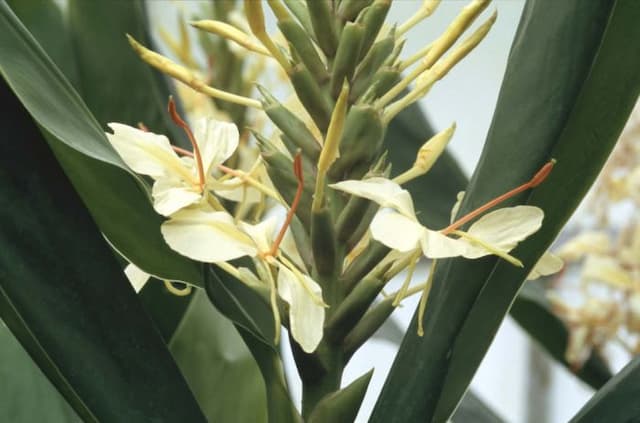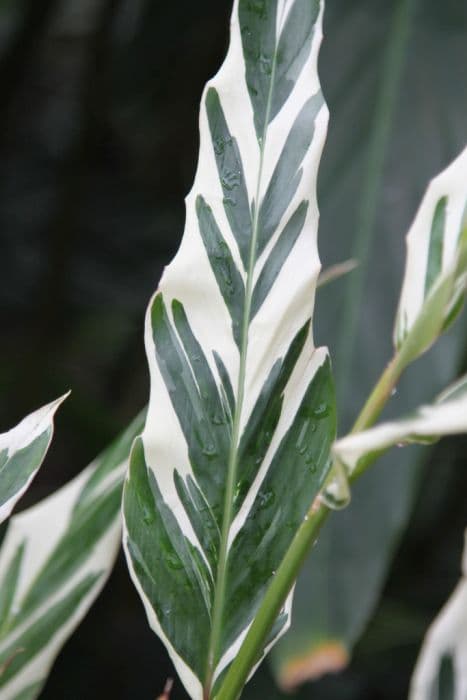Java Ginger Hedychium hasseltii

ABOUT
Hedychium hasseltii, commonly known as the Hasselt's Ginger or the red ginger lily, is a visually striking plant. It features lush foliage, with long and lance-shaped leaves that are deep green, creating a dense and tropical feel. The leaves grow out from the main stem, often arching gracefully. The most distinctive characteristics of this plant are its flowers. They bloom in an inflorescence, which means the flowers are grouped on a stem that extends above the foliage. These blossoms are known for their vibrant coloration and intricate detail. The flowers of the Hasselt's Ginger are a spectrum of fiery shades, often a combination of yellow and red hues, which can give them a sunset-like appearance. They are typically funnel-shaped with a delicate and exotic look, which can be very fragrant, attracting bees, butterflies, and hummingbirds. Each bloom comprises several individual flowers arranged in a dense cluster, with prominent and extended stamen that add to their ornamental allure. The plant has rhizomes underground, which enable it to store nutrients and water, helping it to thrive in various conditions. The overall appearance of Hedychium hasseltii is one that exudes a tropical charm, with its resplendent flowers serving as a captivating highlight against the backdrop of its verdant leaves. It's often used in gardens to create a lush, exotic atmosphere.
About this plant
 Names
NamesFamily
Zingiberaceae
Synonyms
Hasselt's Ginger, Red Ginger Lily, Bunga Kantan
Common names
Gandasulium hasseltii, Hedychium bousigonii, Hedychium gandasulium, Hedychium maximum, Hedychium spicatum var. acuminatum.
 Toxicity
ToxicityTo humans
Indonesian wax ginger, Hedychium hasseltii, is not typically known for being a toxic plant to humans. There is limited information available about the toxicity of this specific species, and it does not appear to be commonly reported as a poisonous plant. However, as with many plants, sensitivity varies between individuals, and some people might experience mild irritation or an allergic reaction to ingesting or handling the plant. If symptoms occur, they may include gastrointestinal discomfort, nausea, vomiting, or skin irritation. It is always advisable to exercise caution and avoid ingesting plants that are not specifically meant for human consumption, and to consult a medical professional if you suspect poisoning.
To pets
Indonesian wax ginger is not widely recognized for being toxic to pets either. Similar to its effects on humans, Hedychium hasseltii does not have well-documented toxic properties. However, pet owners should generally prevent pets from ingesting plants, as they could potentially cause an upset stomach or an allergic reaction. If a pet does ingest part of this plant and shows signs of distress such as vomiting, diarrhea, or unusual behavior, it is important to consult a veterinarian. Always err on the side of caution and keep plants out of reach of pets.
 Characteristics
CharacteristicsLife cycle
Perennials
Foliage type
Evergreen
Color of leaves
Green
Flower color
White
Height
5 feet (1.52 meters)
Spread
2 feet (0.61 meters)
Plant type
Herb
Hardiness zones
10
Native area
Southeast Asia
Benefits
 General Benefits
General Benefits- Ornamental beauty: Hedychium hasseltii, commonly known as the Red Ginger Lily, adds visual appeal to gardens with its attractive foliage and vibrant red flowers.
- Attracts pollinators: The bright blossoms of the Red Ginger Lily attract beneficial pollinators like butterflies and bees, promoting biodiversity.
- Ease of propagation: This plant can be propagated relatively easily through division, making it a cost-effective choice for garden enthusiasts.
- Tolerance to various conditions: Red Ginger Lily is adaptable to a range of soil types and can tolerate partial shade, offering flexibility in garden design.
- Aromatic flowers: The Red Ginger Lily is known for its fragrant flowers, which can enhance the sensory experience in any garden or landscape.
- Low maintenance: Once established, Red Ginger Lily requires minimal care, making it suitable for busy gardeners.
- Cultural significance: In some cultures, the Red Ginger Lily is used in various ceremonies and festivals due to its striking appearance and fragrance.
 Medical Properties
Medical Properties- Anti-inflammatory: Hedychium hasseltii extracts may exhibit anti-inflammatory properties, which could be beneficial in reducing inflammation.
- Analgesic: There is potential for the plant to provide pain-relieving effects.
- Antimicrobial: The plant may have antimicrobial activities against certain bacteria and fungi.
- Antioxidant: Compounds found in Hedychium hasseltii could possess antioxidant properties, potentially protecting the body from oxidative stress.
- Anti-allergic: There might be components in the plant that help in reducing allergic reactions.
 Air-purifying Qualities
Air-purifying QualitiesThis plant is not specifically known for air purifying qualities.
 Other Uses
Other Uses- Hedychium hasseltii, commonly known as Java ginger, can sometimes be used as a natural insect repellent due to its strong aromatic properties that insects might find offensive.
- The stems and leaves of Java ginger may be used in compost or mulch as they decompose, adding nutrients and organic matter to the soil.
- Java ginger's large leaves can be used for wrapping food during cooking, imparting a subtle flavor and helping to retain moisture in the dishes.
- The plant is sometimes incorporated into ornamental gardens for its aesthetic appeal owing to its striking flowers and pleasant fragrance.
- Dried Java ginger flowers can be used in potpourri mixes to add fragrance and to act as a natural deodorizer in homes.
- The juice extracted from the flowers of Java ginger may be used as a natural dye for fabrics, yielding shades of yellow or green depending on the mordant used.
- Java ginger's robust rhizomes can be used to help prevent soil erosion on slopes or riverbanks owing to their dense root structure.
- The flowers of Java ginger can be used in floral arrangements and as cut flowers due to their exotic appearance and lasting fragrance.
- In some cultures, parts of the Java ginger plant are used in traditional handcrafted items such as scented sachets or woven into mats and baskets.
- The plant's tall and dense growth habit allows it to be used as a privacy screen or to create natural partitions in outdoor garden spaces.
Interesting Facts
 Feng Shui
Feng ShuiThe Red Ginger is not used in Feng Shui practice.
 Zodiac Sign Compitability
Zodiac Sign CompitabilityThe Red Ginger is not used in astrology practice.
 Plant Symbolism
Plant Symbolism- Exotic Beauty: Hedychium hasseltii, commonly known as the Java ginger, often symbolizes exotic beauty due to its striking and unusual flowers that captivate attention in any garden or setting.
- Femininity: The delicate and refined appearance of the Java ginger's flowers can be seen as a representation of femininity and grace.
- Intense Fragrance: The Java ginger's strong aromatic presence is sometimes associated with the power to attract and allure, akin to a person's charismatic and enchanting personality.
- Diversity: As the Java ginger thrives in various environments, it symbolizes adaptability and the beauty of diversity in ecosystems and can imply the importance of embracing different cultures and backgrounds.
- Tropical Unique Essence: This plant may represent a special or unique essence that stands out in its native tropical environment, suggesting individuality and the idea of being distinctive in one's surroundings.
 Water
WaterThe Indonesian wax ginger should be watered thoroughly, allowing the top inch of soil to dry out between waterings. In warmer months, this may translate to watering approximately once a week with about half a gallon for a medium-sized plant to maintain consistent soil moisture. During the winter or in cooler temperatures, reduce watering to every other week, ensuring the soil doesn't become waterlogged which can lead to root rot. Regular monitoring of the soil moisture is essential to determine when to water next. Overwatering is a common mistake, so it's better to err on the side of caution and check the soil before adding more water.
 Light
LightThe Indonesian wax ginger thrives in partial shade to partial sun. The ideal spot is one where the plant receives bright, indirect light or filtered sunlight for most of the day. Direct afternoon sun should be avoided as it can scorch the leaves, so a location under the canopy of taller trees or on the east or west-facing side of a building is suitable.
 Temperature
TemperatureIndonesian wax ginger prefers a warm climate and should be kept at temperatures between 60 to 85 degrees Fahrenheit. Temperatures below 50 degrees Fahrenheit can harm the plant, so it's best to avoid exposing it to cold drafts or frost conditions. The ideal temperature for robust growth is within the warmer part of the range, around 70 to 85 degrees Fahrenheit.
 Pruning
PruningPrune the Indonesian wax ginger to encourage bushier growth and to remove any spent flowers or dead foliage. Pruning is best done in late winter or early spring before new growth begins. Cut back old stems to make room for new ones, typically pruning can be done once a year. Always use clean, sharp tools to make precise cuts and avoid tearing the stems.
 Cleaning
CleaningAs needed
 Soil
SoilThe best soil mix for Indonesian Wax Ginger (Hedychium hasseltii) should be rich, well-draining, and high in organic matter, such as a mix of loam, peat, and sand or perlite. The ideal pH for Indonesian Wax Ginger is slightly acidic to neutral, ranging from 6.0 to 7.0.
 Repotting
RepottingIndonesian Wax Ginger (Hedychium hasseltii) should be repotted every 2-3 years or when the plant becomes root-bound. The best time for repotting is in the spring, just before the growing season begins.
 Humidity & Misting
Humidity & MistingIndonesian Wax Ginger (Hedychium hasseltii) thrives in high humidity conditions, ideally between 60-80%. Maintain high humidity around the plant for optimal growth.
 Suitable locations
Suitable locationsIndoor
Give bright, indirect light and keep moist.
Outdoor
Plant in partial shade, protect from cold.
Hardiness zone
8-10 USDA
 Life cycle
Life cycleHedychium hasseltii, commonly known as the Hasselt's ginger, starts its life cycle when a seed germinates, usually in warm, moist soil conditions, and a primary shoot emerges. The seedling grows into a juvenile plant with characteristic lance-shaped leaves on upright stems. As the plant matures, it develops a rhizome, an underground stem from which new shoots and roots emerge, allowing the plant to spread and perennialize. Upon reaching maturity, Hasselt's ginger produces fragrant flowers, typically in terminal clusters; these are pollinated by insects, leading to the formation of seeds. After flowering, the aerial parts may die back, but the rhizome survives underground and can produce new growth the following season. This cycle continues yearly, with the plant going through phases of growth, flowering, and dormancy, largely influenced by seasonal climatic changes.
 Propogation
PropogationPropogation time
Spring to Summer
Propogation: The propagating of Hedychium hasseltii, commonly known as the red ginger lily, is most commonly done through division of rhizomes. This method is typically carried out during the late winter or early spring before the plant begins its active growth phase. Gardeners should carefully dig up the entire plant and gently separate the rhizomes, ensuring that each section has at least one growth bud. These divisions can be directly replanted in well-draining soil at a depth of approximately 2 to 4 inches (5 to 10 centimeters), spaced about 18 inches (45 centimeters) apart to allow for ample growth. It is important to keep the soil consistently moist, but not waterlogged, to encourage rooting and new growth.









